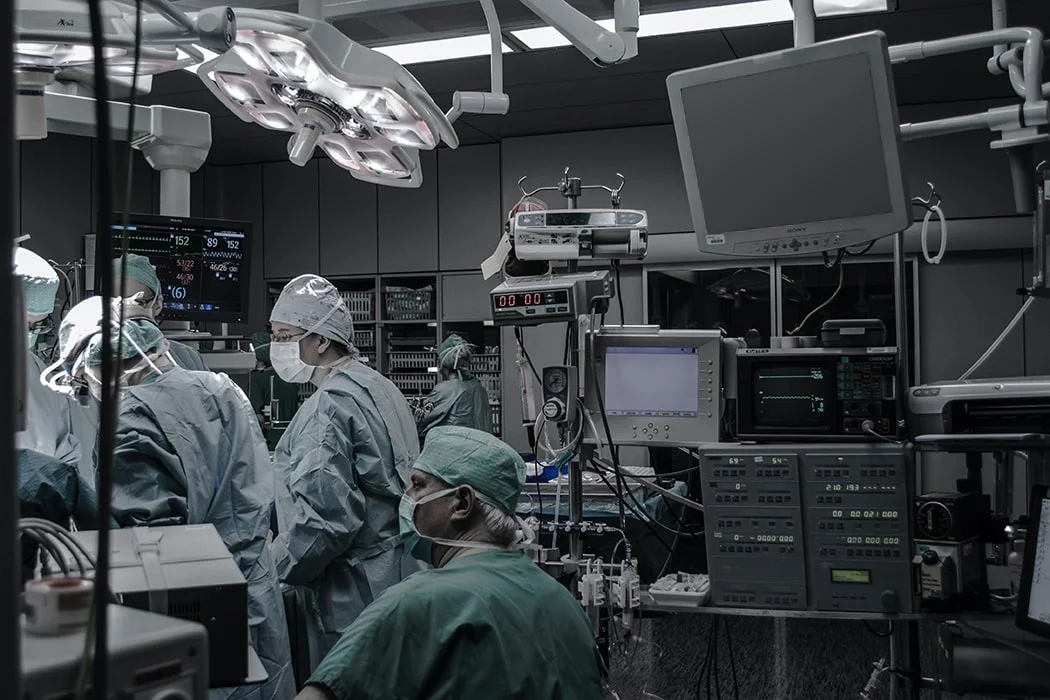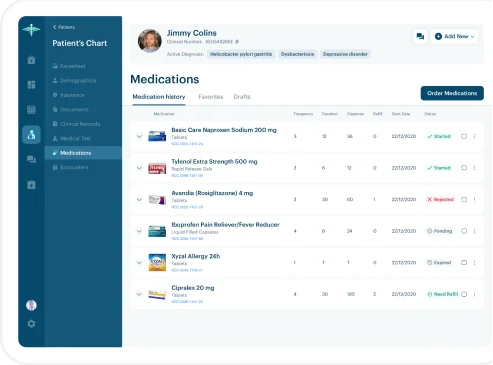IoT healthcare solutions
-
Improve patient outcomes and acquire valuable data insights with an IoT healthcare solution
-
Save money and time on the part of facility staff by eliminating manual asset tracking
-
Ensure the secure and reliable collection of patients’ vital data
-
Provide patients with personalized care by implementing IoT technologies
Why choose Yalantis as your healthcare IoT solutions company?
-
9/10
net promoter score (NPS) among healthcare clients
-
30+
IoT products delivered for our clients
-
7+
years of experience in the IoT domain
-
20+
integrated and supported IoT devices
Yalantis IoT solutions for healthcare
We incorporate IoT technologies into diverse healthcare systems, expanding their functionality and collecting valuable data.
-
Remote patient monitoring (RPM) support
-
Device integration for monitoring vital data and specific health metrics
-
Connection to smart wearable devices
-
Integration with vital data from cloud solutions
-
Assessment of health risks based on measurements
-
-
Medication management
-
Dosage monitoring
-
Supervision of patients’ adherence to schedules
-
Clinical decision support
-
Patient care coordination
-
-
Asset tracking
-
Real-time location tracking
-
Inventory management
-
Restocking notifications
-
-
Additional services
-
Consultations on device selection and configuration
-
Work with hardware (e.g. support, calibration)
-
Data management and analytics
-
Security and compliance
-
System reliability and error handling
-
Improve patient care and ensure the visibility of your medical assets
We can integrate diverse IoT devices into your healthcare practice and ensure their interoperability with your existing healthcare systems
IoT for healthcare case studies
Gather vital patient measurements and clinical data at lightning speed
We provide IoT healthcare solutions that help you generate valuable data insights, efficiently track your medical assets, and ensure personalized patient care
INSIGHTS NTO IOT HEALTHCARE SOLUTIONS

Remote patient monitoring solutions for healthcare providers
How to stay relevant in the highly competitive healthcare market with remote patient monitoring? Learn all about implementing RPM into your telehealth solution.

How to remotely manage IoT devices: ensuring IoT remote management of large device networks
Learn an approach to ensuring remote IoT network management and building an IoT remote management system. Read about the pitfalls associated with remote management in IoT and how to overcome them.

E-prescription app development: how to make your system efficient
Check out how you can develop e-prescription (eRx) software that is smart, user-friendly, and HIPAA-compliant in our guide to e-prescribing app development.
What are the benefits of IoT healthcare solutions?
Integrating IoT devices into healthcare solutions can lead to a range of benefits, including improved patient outcomes, increased efficiency and productivity, cost savings, greater patient engagement, better decision-making, and regulatory compliance. Plus, there are many IoT devices on the market that can elevate healthcare services, including wearables (smartwatches and fitness trackers), remote patient monitoring devices (blood glucose monitors and blood pressure cuffs), and asset tracking devices (RFID tags and beacons).
However, integrating IoT healthcare solutions can pose several challenges, including with regards to data security and privacy, regulatory compliance, interoperability, and the need for specialized technical expertise. Partnering with an experienced healthcare software development company can enable you to easily overcome these challenges and quickly reap the benefits of IoT device integration.
What are your best practices for developing healthcare IoT solutions?
Best practices for integrating medical IoT devices into healthcare solutions include conducting a thorough risk assessment to identify potential security and privacy risks. It’s also critical to ensure that IoT solutions comply with industry requirements and laws such as HIPAA.
Another best practice is gathering feedback from patients and healthcare providers to ensure that your IoT solution is user-friendly and aligned with their needs. Additionally, it is important to work with experienced IoT vendors and partners who have a deep understanding of the healthcare industry and can provide robust technical support.
What are the common use cases of IoT solutions for healthcare?
IoT solutions can be used to improve medication adherence by providing patients with reminders to take their medications. For example, a smart pill bottle can send an alert to a patient’s smartphone when it’s time to take medications. Additionally, IoT devices can be used to monitor patients’ medication use in real time, which can help healthcare providers identify potential issues with medication adherence and intervene before they become serious.
Another common IoT use case is improving patient safety by monitoring patients’ health in real time and alerting healthcare providers about potential safety risks. For example, IoT sensors can detect a fall and alert a healthcare provider about an incident. Additionally, IoT can be used to monitor patients’ vital signs and detect potential issues early, leading to faster interventions and improved patient outcomes.
IoT healthcare solutions can also be used to improve clinical trials by collecting real-time data on patients’ health and behaviors. For example, wearables can be used to track patients’ physical activity and sleep patterns, which can provide valuable insights into the impact of interventions on patients’ health. Additionally, IoT devices can be used to monitor patients’ medication use and collect data on side effects, which can help healthcare providers identify potential issues with new treatments.
How can an IoT healthcare solution be used to improve healthcare supply chain management?
IoT solutions can also improve healthcare supply chain management by providing real-time data on inventory levels and medication use. For example, IoT sensors can be used to track the location and status of medical equipment, such as wheelchairs and IV pumps, helping healthcare practitioners optimize equipment use and reduce waste. Additionally, IoT can be used to monitor the temperature and humidity of pharmaceutical products during transportation and storage, ensuring that medications are stored in a suitable environment and remain effective.
Remote IoT device management for healthcare IoT solutions
Adopting large numbers of Internet of Medical Things (IoMT) devices into your healthcare workflow can pose the challenge of efficiently managing them, especially remotely. When IoT devices were only entering the market, it was necessary to locate IoT gateways in close proximity to sensors, as only then could data be effectively gathered. Now, we have solutions that enable remote IoT device management, allowing for locating gateways away from sensors, easily onboarding and adding new IoMT devices, and updating and troubleshooting gateways at a distance.
Primarily, remote IoT device management is enabled via a wide range of modern communication protocols including LoRaWan, Wi-Fi, LwM2M, RFID, and MQTT. The choice of communication method depends on the type of devices used and the capabilities of the IoT gateway.
The flow for managing IoMT devices consists of a few critical stages:
- IoT sensors collect patient or clinical data and transfer it to the connectivity devices or IoT gateways that store this data in the cloud.
- Next comes data processing, which includes converting raw data into formats acceptable for further data analysis.
- Data analytics is the last step in IoT device management and usually involves providing healthcare practitioners with dashboards containing information about the patient’s condition or insights on medical assets.
Healthcare IoT solutions can be considered fully complete only if the collected data goes through the above-mentioned three-stage process.
4 practical steps to take for efficient IoT device management in healthcare
Here are four steps you can take to ensure effective remote management of your IoMT devices:
Step 1. Select healthcare IoT device providers with a robust infrastructure. You should look for IoMT device providers that have a well-established IoT infrastructure and a developed R&D department that constantly works on firmware improvements. It’s also essential for your IoMT device vendor to be FDA-approved and HIPAA-compliant.
Step 2. Choose an IoT device management platform. Major cloud providers offer a vast variety of IoT device management platforms that enable IoT device management from a single place. Such platforms include AWS IoT Core and Azure IoT. Importantly, once you choose an IoT cloud platform, you’ll need to make use of other services by the same cloud provider to ensure a seamless IoT management experience.
Step 3. Ensure synchronization between the cloud and IoT gateways. In most cases, cloud vendors provide you with all the necessary tools for quickly syncing between sensors, gateways, and the cloud, but often you’ll need to make certain workarounds to make this synchronization smooth and foolproof. As an experienced IoT solutions provider, Yalantis can ensure quick and secure synchronization with ease.
Step 4. Develop a user-facing IoT network management system. You can find many ready-made IoT management systems, but a custom IoT healthcare solution can have a user interface and features that precisely meet your medical practice’s needs for efficient and quick medical device monitoring. With a custom IoT control system, your staff can easily locate, configure, and update gateways using a convenient interface. Developing a custom IoT management web platform also involves providing support for long-running operations, as IoT equipment is known for its limited computing power.
Establishing a robust IoT management ecosystem is just as critical for medical practices with a small set of integrated devices as it is for large hospital networks with many IoMT devices across multiple healthcare facilities. With an IoT management ecosystem, you can ensure a consistent flow of actionable medical insights, stay updated on changes in your IoT network, and easily onboard and add new IoMT devices to further enhance your network.
The Yalantis IoT development team customizes every IoT solution to the needs of the particular healthcare practice, as each company has a different set of IoT devices. When you work with Yalantis, you get access to full-service healthcare IoT device integration, as we can assist you with each of the four steps of IoT management discussed above.
Integrate IoT devices into your digital healthcare network to deliver more value for patients
Develop a custom IoT solution to more accurately monitor your patients’ health and gain complete visibility of your organization’s workflow



